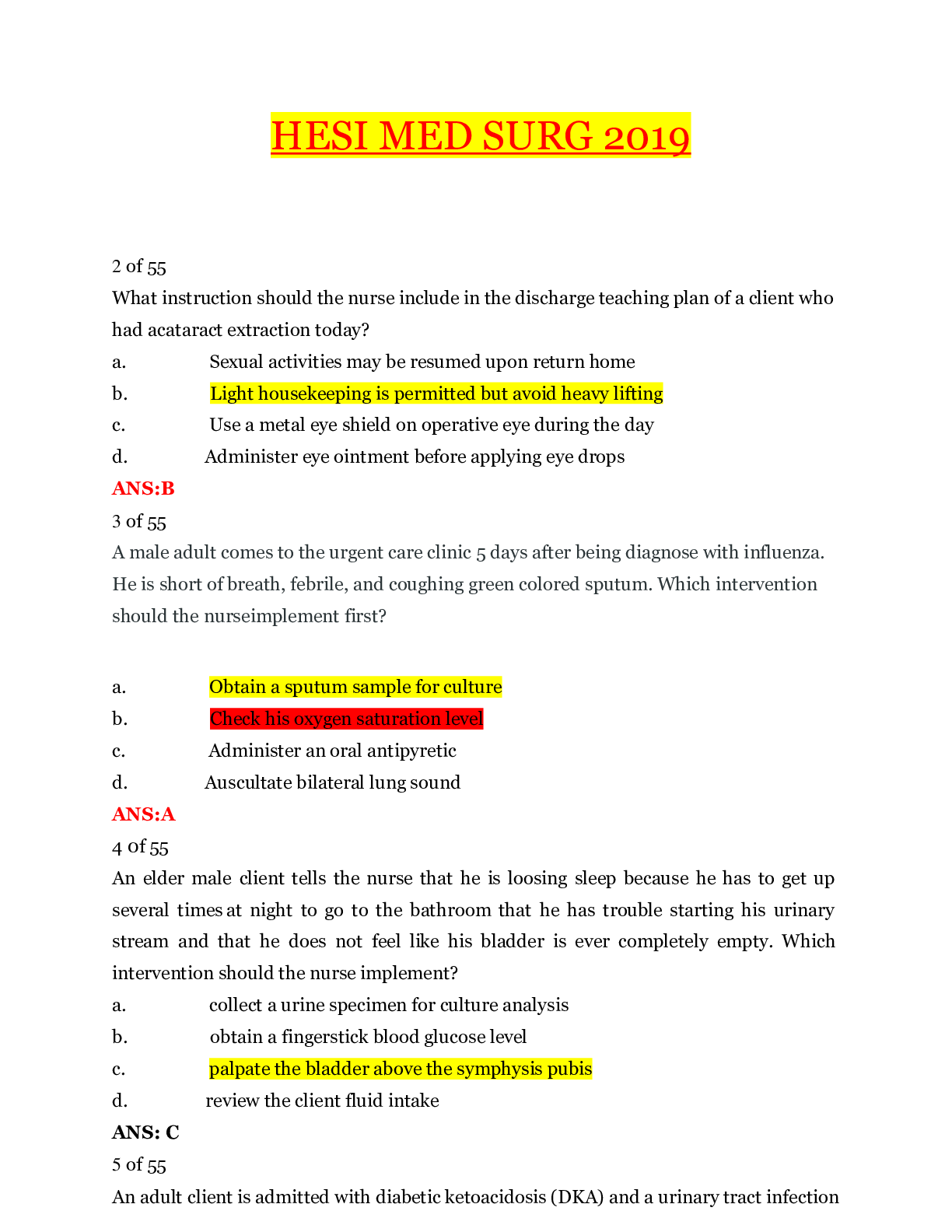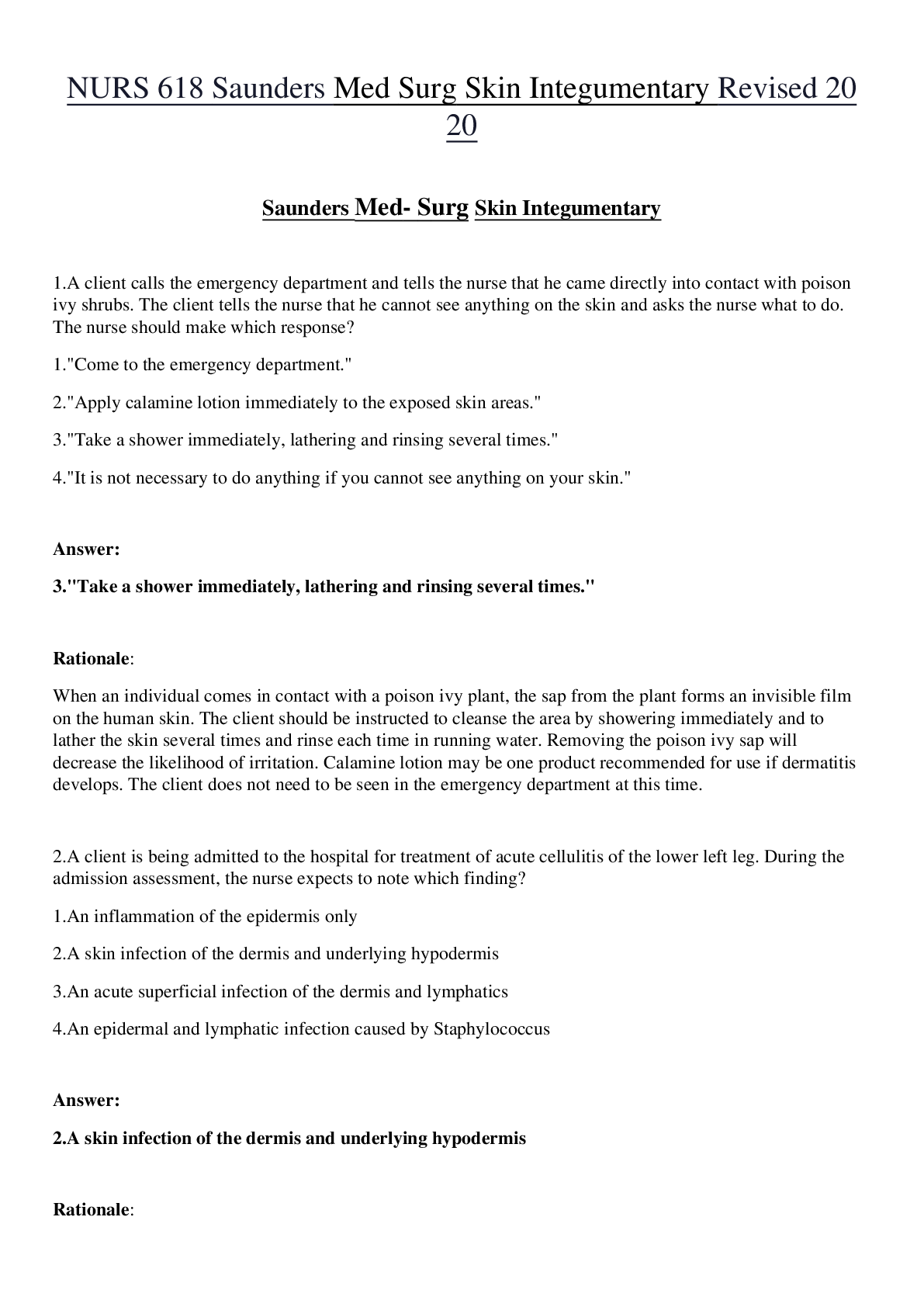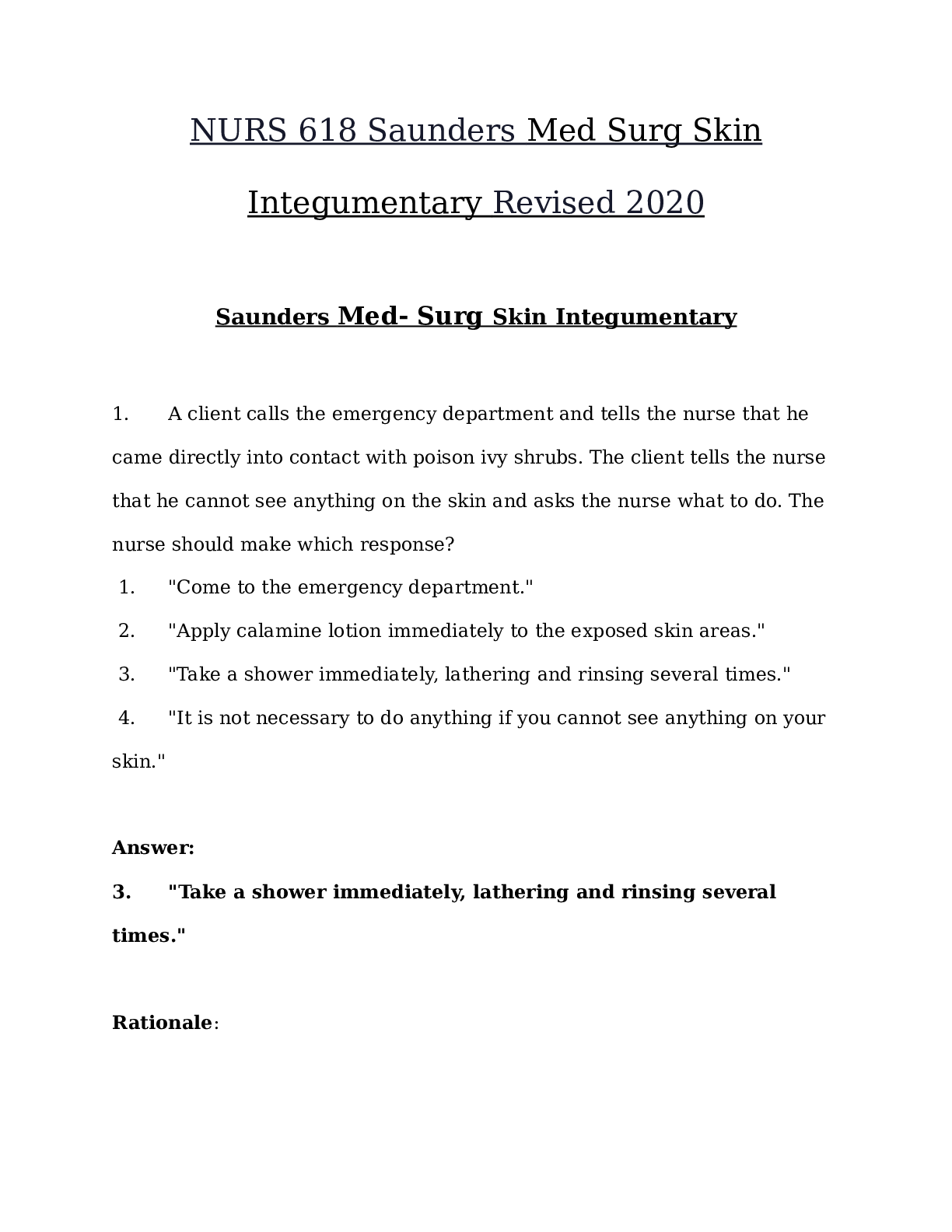*NURSING > MED-SURG EXAM > NURS 618 Saunders Med Surg Cardiovascular Revised 2020 | NURS618 Saunders Med Surg Cardiovascular (All)
NURS 618 Saunders Med Surg Cardiovascular Revised 2020 | NURS618 Saunders Med Surg Cardiovascular
Document Content and Description Below
NURS 618 Saunders Med Surg Cardiovascular Revised 2020 Saunders Med Surg Cardiovascular 1. A client admitted to the hospital with chest pain and a history of type 2 diabetes mellitus is sche... duled for cardiac catheterization. Which medication would need to be withheld for 24 hours before the procedure and for 48 hours after the procedure? • Glipizide • Metformin • Repaglinide • Regular insulin Answer: 2. Metformin Rationale: Metformin needs to be withheld 24 hours before and for 48 hours after cardiac catheterization because of the injection of contrast medium during the procedure. If the contrast medium affects kidney function, with metformin in the system the client would be at increased risk for lactic acidosis. The medications in the remaining options do not need to be withheld 24 hours before and 48 hours after cardiac catheterization. 3. The nurse is reviewing an electrocardiogram rhythm strip. The P waves and QRS complexes are regular. The PR interval is 0.16 seconds, and QRS complexes measure 0.06 seconds. The overall heart rate is 64 beats/minute. Which action should the nurse take? 1. Check vital signs. 2. Check laboratory test results. 3. Notify the health care provider. 4. Continue to monitor for any rhythm change. Answer: 4. Continue to monitor for any rhythm change. Rationale: Normal sinus rhythm is defined as a regular rhythm, with an overall rate of 60 to 100 beats/minute. The PR and QRS measurements are normal, measuring between 0.12 and 0.20 seconds and 0.04 and 0.10 seconds, respectively. There are no irregularities in this rhythm currently, so there is no immediate need to check vital signs or laboratory results, or to notify the health care provider. Therefore, the nurse would continue to monitor the client for any rhythm change. 4. A client is wearing a continuous cardiac monitor, which begins to sound its alarm. The nurse sees no electrocardiographic complexes on the screen. Which is the priority nursing action? • Call a code. • Call the health care provider. • Check the client's status and lead placement. • Press the recorder button on the electrocardiogram console. Answer: 3. Check the client's status and lead placement. Rationale: Sudden loss of electrocardiographic complexes indicates ventricular asystole or possibly electrode displacement. Accurate assessment of the client and equipment is necessary to determine the cause and identify the appropriate intervention. The remaining options are secondary to client assessment. 7. A client's electrocardiogram strip shows atrial and ventricular rates of 110 beats/minute. The PR interval is 0.14 seconds, the QRS complex measures 0.08 seconds, and the PP and RR intervals are regular. How should the nurse correctly interpret this rhythm? • Sinus tachycardia • Sinus bradycardia • Sinus dysrhythmia • Normal sinus rhythm Answer: 1. Sinus tachycardia Rationale: Sinus tachycardia has the characteristics of normal sinus rhythm, including a regular PP interval and normal-width PR and QRS intervals; however, the rate is the differentiating factor. In sinus tachycardia, the atrial and ventricular rates are greater than 100 beats/minute. 8. The nurse is assessing the neurovascular status of a client who returned to the surgical nursing unit 4 hours ago after undergoing aortoiliac bypass graft. The affected leg is warm, and the nurse notes redness and edema. The pedal pulse is palpable and unchanged from admission. How should the nurse correctly interpret the client's neurovascular status? • The neurovascular status is normal because of increased blood flow through the leg. • The neurovascular status is moderately impaired, and the surgeon should be called. • The neurovascular status is slightly deteriorating and should be monitored for another hour. • The neurovascular status is adequate from an arterial approach, but venous complications are arising. Answer: 1. The neurovascular status is normal because of increased blood flow through the leg. Rationale: An expected outcome of aortoiliac bypass graft surgery is warmth, redness, and edema in the surgical extremity because of increased blood flow. The remaining options are incorrect interpretations. 12. The home care nurse is providing instructions to a client with an arterial ischemic leg ulcer about home care management and self-care management. Which statement, if made by the client, indicates a need for further instruction? • "I need to be sure not to go barefoot around the house." • "If I cut my toenails, I need to be sure that I cut them straight across." • "It is all right to apply lanolin to my feet, but I shouldn't place it between my toes." • "I need to be sure that I elevate my leg above the level of my heart for at least an hour every day." Answer: 4. "I need to be sure that I elevate my leg above the level of my heart for at least an hour every day." Rationale: Foot care instructions for the client with peripheral arterial disease are the same as those for a client with diabetes mellitus. The client with arterial disease, however, should avoid raising the legs above the level of the heart unless instructed to do so as part of an exercise program or if venous stasis is also present. The client statements in the remaining options are correct statements, and indicate that the teaching has been effective. 13. The nurse is providing instructions to a client with a diagnosis of hypertension regarding high-sodium items to be avoided. The nurse instructs the client to avoid consuming which item? • Bananas • Broccoli • Antacids • Cantaloupe Answer: 3. Antacids Rationale: The sodium level can increase with the use of several types of products, including toothpaste and mouthwash; over-the-counter medications such as analgesics, antacids, laxatives, and sedatives; and softened water and mineral water. Clients are instructed to read labels for sodium content. Water that is bottled, distilled, deionized, or demineralized may be used for drinking and cooking. Fresh fruits and vegetables are low in sodium. 14. The nurse is preparing discharge instructions for a client with Raynaud's disease. The nurse should plan to provide which instruction to the client? • Use nail polish to protect the nail beds from injury. • Wear gloves for all activities involving the use of both hands. • Stop smoking because it causes cutaneous blood vessel spasm. • Always wear warm clothing, even in warm climates, to prevent vasoconstriction Answer: 3. Stop smoking because it causes cutaneous blood vessel spasm. Rationale: Raynaud's disease is peripheral vascular disease characterized by abnormal vasoconstriction in the extremities. Smoking cessation is one of the most important lifestyle changes that the client must make. The nurse should emphasize the effects of tobacco on the blood vessels and the principles involved in stopping smoking. The nurse needs to provide information to the client about smoking cessation programs available in the community. It is not necessary to wear gloves for all activities, nor should warm clothing be worn in warm climates. - - - - - - - - - - - - - - - - - - - - - - - - Answer: 4. "ST segment elevation or depression can indicate ischemia." Rationale: An ECG taken during a chest pain episode captures ischemic changes, which include ST segment elevation or depression. Tall, peaked T waves may indicate hyperkalemia. A prolonged PR interval indicates first-degree heart block. A widened QRS complex indicates delay in intraventricular conduction, such as a bundle branch block. 122. The nurse is preparing to ambulate a client on the third day after cardiac surgery. What should the nurse plan to do to enable the client to best tolerate the ambulation? 1. Remove telemetry equipment. 2. Provide the client with a walker. 3. Premedicate the client with an analgesic. 4. Encourage the client to cough and breathe deeply. Answer: 3. Premedicate the client with an analgesic. Rationale: The nurse should encourage regular use of pain medication for the first 48 to 72 hours after cardiac surgery because analgesia will promote rest, decrease myocardial oxygen consumption resulting from pain, and allow better participation in activities such as coughing, deep breathing, and ambulation. Providing the client with a walker and encouraging the client to cough and breathe deeply will not help in tolerating ambulation. Removal of telemetry equipment is contraindicated unless prescribed. 123. A client with rapid-rate atrial fibrillation asks the nurse why the health care provider (HCP) is going to perform carotid sinus massage. The nurse educates the client about the treatment. Which statement by the client indicates that the teaching has been effective? 1. "The vagus nerve slows the heart rate." 2. "The diaphragmatic nerve slows the heart rate." 3. "The diaphragmatic nerve overdrives the rhythm." 4. "The vagus nerve increases the heart rate, overdriving the rhythm." Answer: 1. "The vagus nerve slows the heart rate." Rationale: Carotid sinus massage is one maneuver used for vagal stimulation to decrease a rapid heart rate and possibly terminate a tachydysrhythmia. Others include inducing the gag reflex and asking the client to strain or bear down. Medication therapy is often needed as an adjunct to keep the rate down or maintain the normal rhythm. The remaining options are incorrect descriptions of this procedure. 124. The nurse assesses the sternotomy incision of a client on the third day after cardiac surgery. The incision shows some slight puffiness along the edges and is non-reddened, with no apparent drainage. The client's temperature is 99°F (37.2°C) orally. The white blood cell count is 7500 mm3 (7.5 × 109/L). How should the nurse interpret these findings? 1. Incision is slightly edematous but shows no active signs of infection. 2. Incision shows early signs of infection, although the temperature is nearly normal. 3. Incision shows no sign of infection, although the white blood cell count is elevated. 4. Incision shows early signs of infection, supported by an elevated white blood cell count. Answer: 1. Incision is slightly edematous but shows no active signs of infection. Rationale: Sternotomy incision sites are assessed for signs and symptoms of infection, such as redness, swelling, induration, and drainage. An elevated temperature and white blood cell count 3 to 4 days postoperatively usually indicate infection. Therefore, the option indicating that there is slight edema and no active signs of infection is correct. 125. The nurse notes bilateral 2 edema in the lower extremities of a client with myocardial infarction who was admitted 2 days ago. Based on this observation, what should the nurse plan to do first? 1. Review intake and output records for the last 2 days. 2. Prescribe daily weights starting on the following morning. 3. Change the time of diuretic administration from morning to evening. 4. Request a sodium restriction of 1 g/day from the health care provider (HCP). Answer: 1. Review intake and output records for the last 2 days. Rationale: Edema, the accumulation of excess fluid in the interstitial spaces, can be measured by intake greater than output and by a sudden increase in weight. Therefore, the nurse should review intake and output records for the last 2 days. Diuretics should be given in the morning whenever possible to avoid nocturia. Strict sodium restriction 128. The nurse is reviewing the procedure for performance of an electrocardiogram (ECG). Which action by the nurse indicates understanding of the correct position for the V1lead when performing a 12-lead electrocardiogram? 1. "The lead should be placed on the fourth intercostal space left sternal border." 2. "The lead should be placed on the fourth intercostal space right sternal border." 3. "The lead should be placed on the fifth intercostal space left midaxillary line." 4. "The lead should be placed on the fifth intercostal space left midclavicular line." Answer: 2. "The lead should be placed on the fourth intercostal space right sternal border." Rationale: The correct location for the V1 lead is the fourth intercostal space right sternal border. Therefore, the locations in the remaining options are incorrect. 129. After instruction on the application of antiembolism stockings, the nurse determines that the client requires further teaching if which of these actions is performed? 1. The client puts on the stockings before getting out of bed. 2. The client bunches up the stockings for easier application. 3. The client ensures that stockings are pulled up all the way. 4. The client ensures that the rough seams of the stockings are on the outside. Answer: 2. The client bunches up the stockings for easier application. Rationale: When applying antiembolism stockings, the client should not bunch up the stockings. Instead, the client should place the hand inside the stocking and pull the heel out. The foot of the stocking should then be placed over the client's foot and the rest of the stocking pulled up the leg. This will help to prevent wrinkling and twisting of the stocking. The remaining options demonstrate correct application of the stockings. 130. The nurse is assessing a client newly diagnosed with mild hypertension. Which assessment finding should the nurse expect? 1. Asymptomatic 2. Shortness of breath 3. Visual disturbances 4. Frequent nosebleeds Answer: 1. Asymptomatic Rationale: Hypertensive clients often have no symptoms until target organ involvement, which happens with very high blood pressure. This is why it is often noted as the "silent killer." The remaining options are incorrect because those clinical manifestations occur with severely high hypertension. 131. The nurse monitors the client for which condition as a complication of polycythemia vera? 1. Thrombosis 2. Hypotension 3. Cardiomyopathy 4. Pulmonary edema - - - - - - - - - - - - - - - - - - - - Rationale: Obesity and sodium intake are modifiable risk factors for hypertension. These are of the utmost importance because they can be changed or modified by the individual through a regular exercise program and careful monitoring of sodium intake. Protein intake has no relationship to hypertension. 145. The nurse identifies that a client is having occasional premature ventricular contractions (PVCs) on the cardiac monitor. The nurse reviews the client's laboratory results and determines that which result would be consistent with the observation? 1. Serum chloride level of 98 mEq/L (98 mmol/L) 2. Serum sodium level of 145 mEq/L (145 mmol/L) 3. Serum calcium level of 10.5 mg/dL (2.75 mmol/L) 4. Serum potassium level of 2.8 mEq/L (2.8 mmol/L) Answer: 4. Serum potassium level of 2.8 mEq/L (2.8 mmol/L) Rationale: The nurse should check the client's serum laboratory study results for hypokalemia. The client may experience PVCs in the presence of hypokalemia because this electrolyte imbalance increases the electrical instability of the heart. The values noted in the remaining options are normal. 146. The nurse is performing a cardiovascular assessment on a client. Which parameter would the nurse assess to gain the best information about the client's left-sided heart function? 1. Breath sounds 2. Peripheral edema 3. Hepatojugular reflux 4. Jugular vein distention Answer: 1. Breath sounds Rationale: The client with heart failure may present with different signs and symptoms according to whether the right or the left side of the heart is failing. Peripheral edema, jugular vein distention, and hepatojugular reflux are all indicators of impaired right-sided heart function. Breath sounds are an accurate indicator of left-sided heart function. [Show More]
Last updated: 2 years ago
Preview 1 out of 85 pages

Buy this document to get the full access instantly
Instant Download Access after purchase
Buy NowInstant download
We Accept:

Reviews( 0 )
$15.00
Can't find what you want? Try our AI powered Search
Document information
Connected school, study & course
About the document
Uploaded On
Nov 04, 2020
Number of pages
85
Written in
Additional information
This document has been written for:
Uploaded
Nov 04, 2020
Downloads
1
Views
164





















